5 aboard Titanic tourist sub are dead after ‘catastrophic implosion’
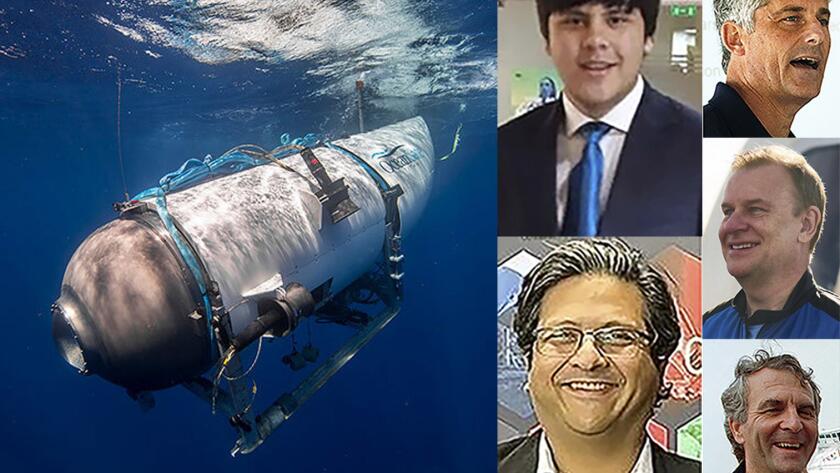
The five passengers on a sub that vanished on a trip to explore the Titanic wreckage have died after a catastrophic implosion, U.S. Coast Guard says.
- Show more sharing options
- Copy Link URL Copied!
All five passengers aboard a submersible that vanished while on a dive to explore the Titanic wreck site have died, officials said Thursday after underwater robots discovered seafloor debris from the sub that was “consistent with a catastrophic implosion.”
A robot from the Canadian vessel Horizon Arctic discovered several major pieces of the 21-foot sub, the Titan , in a debris field about 1,600 feet from the bow of the Titanic, U.S. Coast Guard Rear Adm. John W. Mauger said at a news conference.
“The debris is consistent with the catastrophic loss of the pressure chamber,” Mauger said.
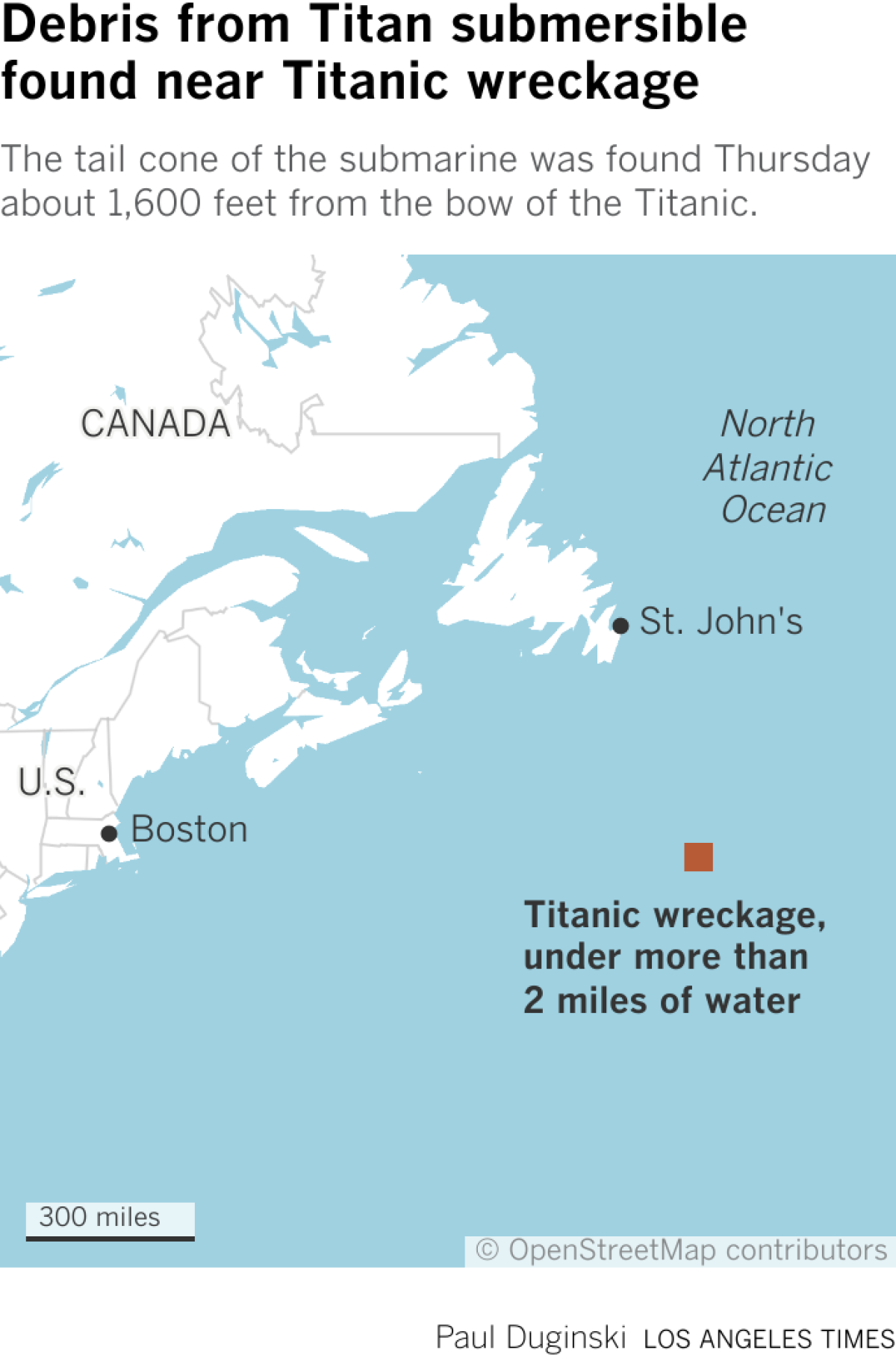
The families of the passengers have been notified, he said.
“On behalf of the U.S. Coast Guard and the entire unified command, I offer my deepest condolences to the families,” he said. “I can only imagine what this has been like for them. I hope that this discovery provides some solace during this difficult time.”
The five passengers were Stockton Rush, the pilot of the exploration and chief executive of OceanGate Expeditions, which owns and operates the sub; Hamish Harding , chairman of Action Aviation, a Dubai-based aircraft dealer; Paul-Henry Nargeolet, a veteran and accomplished diver with more than 30 trips to the wreck site; and Pakistani businessman Shahzada Dawood and son Suleman.

OceanGate said in a statement that its “hearts are with these five souls and every member of their families during this tragic time.”
“These men were true explorers who shared a distinct spirit of adventure and a deep passion for exploring and protecting the world’s ocean,” the company said. “We grieve the loss of life and joy they brought to everyone they knew.”

World & Nation

‘Catastrophic’ safety concerns raised about sub long before ill-fated Titanic voyage
Long before a submersible vanished on an expedition to explore the wreck of the Titanic, concerns were raised about the safety of the vessel.
June 21, 2023
The sub was reported missing after it lost contact with the Canadian research vessel Polar Prince about 1 hour and 45 minutes into its dive Sunday about 900 miles east of Cape Cod, Mass., the Coast Guard said.
Its disappearance set off an international search-and-rescue effort , as crews raced around the clock using specialized equipment to find the sub, which was designed to have an initial air supply of 96 hours. Officials also said it had only “limited rations” of food and water.
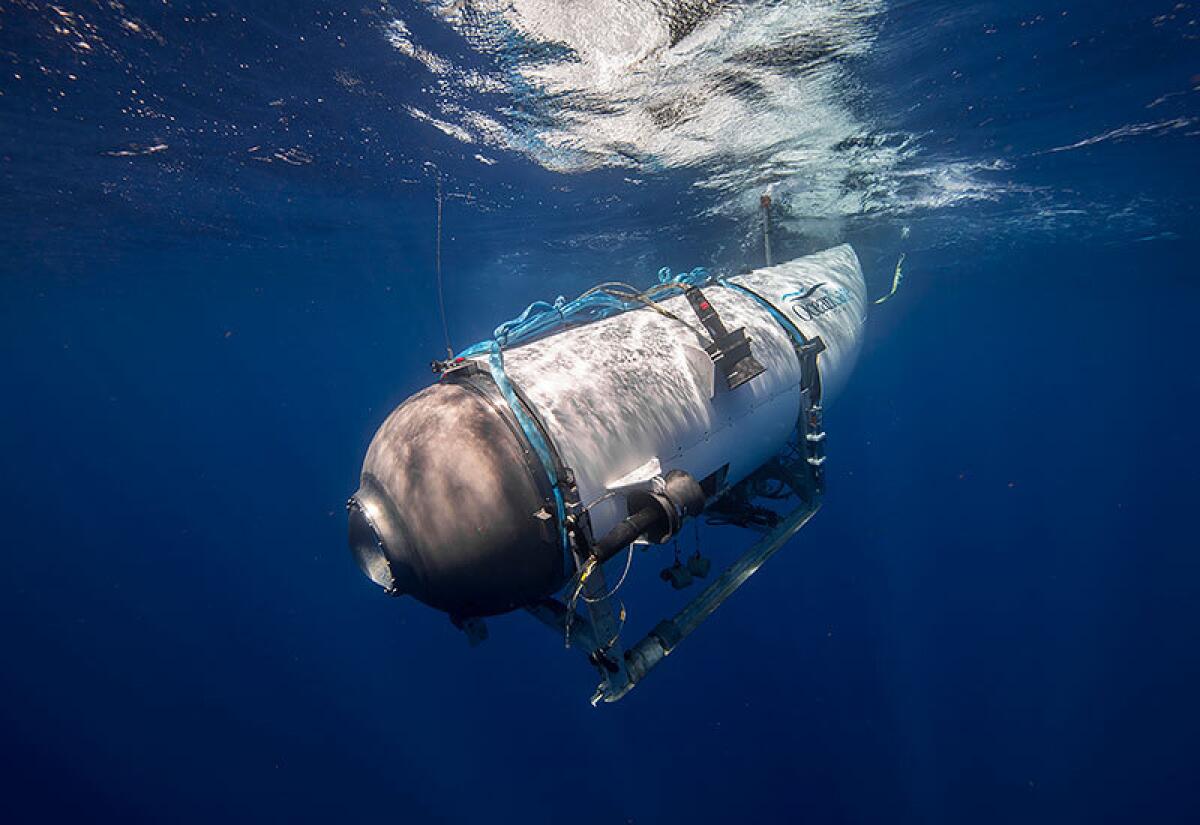
The search grew to 10,000 square miles, roughly the size of Massachusetts, and went 2½ miles deep. Through the days-long effort, officials maintained optimism that the operation would remain a search-and-rescue effort and not a recovery mission.
Assets launched in the search included American and Canadian aerial support vessels that scanned the ocean’s surface and subsurface using sonobuoys; U.S. Navy divers; coast guard and research vessels from Canada, France and Norway, some of which were equipped with highly specialized remote-operated vehicles that could work on the ocean’s floor; and assistance from commercial vessels.
A moment of promise came Tuesday when the Coast Guard confirmed reports that banging noises were detected on the seafloor by sonobuoys dropped from Canadian aircraft. Although officials said the origins of the sounds were unclear, they became the target of search efforts.
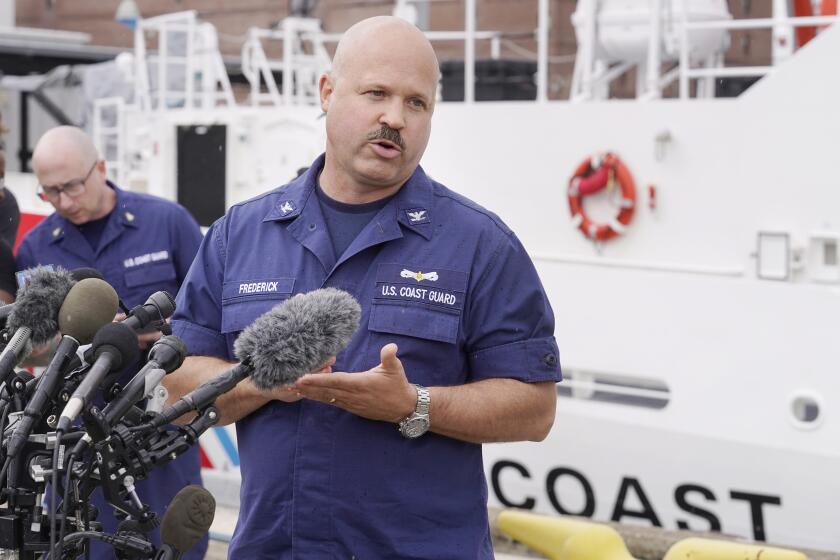
Sounds described as ‘rhythmic tapping’ on hull heard in search for Titanic tourist sub
The use of remotely operated vehicles in the search for the Titanic tourist submersible carrying five people has yielded no results, the U.S. Coast Guard said.
At the news conference Thursday, Mauger said the underwater noises , which were also observed Wednesday, did not appear to be connected to the sub’s location. The implosion would generate “significant broadband sound” that would have been picked up by the sonobuoys, he said.
Paul Hankins, a salvage expert for the U.S. Navy, said five major pieces of debris from the Titan were found, including the nose cone, which was outside of the pressure hull. Crews also found a large debris field that contained the front-end bell of the pressure hull.
“That was the first indication there was a catastrophic event,” he said. A second, smaller debris field contained the other end of the pressure hull and other wreckage that compromised the totality of the vessel.

How The Times covered the sinking of the Titanic: ‘The annihilated Leviathan’
June 22, 2023
Officials said that the debris was in an area away from the Titanic wreckage in a patch of smooth ocean floor and that there were no signs the vessel collided with the historic ship. The size of the debris field and the vessel’s last-known location are consistent with an “implosion in the water column,” officials said.
Mauger said it is too early to tell when the vessel imploded, and added that listening equipment used throughout the search did not detect any type of catastrophic event.
However, a U.S. government official familiar with the incident but not authorized to speak to the media told The Times that technology designed to listen to the ocean for movement captured the sound of the submersible imploding around the time communications were lost. The news was first reported by the Wall Street Journal, which noted the sound “anomaly.”
When asked whether the victims’ remains might be recovered, Mauger said he did not have an answer, reiterating the implosion and underlining the ocean’s harsh conditions. “This is an incredibly unforgiving environment down there on the seafloor,” he said.
Like the search-and-rescue efforts, the investigation into what happened will be complex, Mauger said, because of the remote location where the event occurred and because it involves the government agencies of several countries whose citizens were aboard.
The composite material used to build the sub and a lack of safety systems will be the focus of a maritime inquiry, which most likely will involve Canadian and U.S. investigators, according to sources familiar with such operations.
Nine vessels were at the location Thursday, and demobilization efforts are expected to take place over the next 24 hours. But remote-operated vehicles will continue to map the ocean floor, Mauger said, and officials are working to develop a timeline of the implosion.
“I know that there’s also a lot of questions about how, why and when did this happen,” Mauger said. “Those are questions that we will collect as much information as we can on now.”
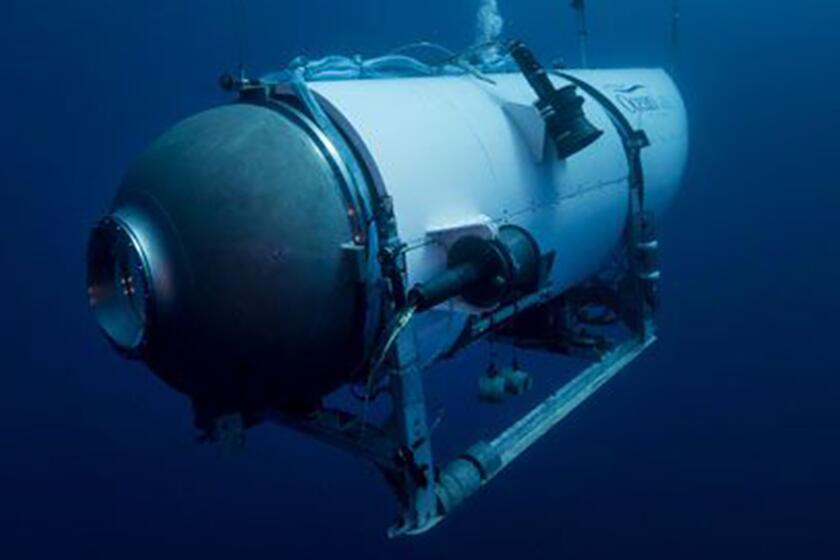
Entertainment & Arts
Commentary: As those aboard the Titan submersible suffered, social media laughed
The exploitative coverage of the death and terror unfolding in real time as the search for the Titan sub continued was compounded by the public’s reaction on TikTok and Twitter.
OceanGate has been running expeditions with “citizen explorers” to the Titanic since 2021 on its Titan sub, according to its website. But as the search unfolded, new details emerged that submersible industry leaders, oceanographers and former employees had long sent warning signs about the Titan.
The Manned Underwater Vehicles Committee at the Marine Technology Society, which advocates for marine technology and resources, wrote a private letter to Rush in 2018 calling on him to allow for a third-party safety review of the Titan. The letter said the marketing for the Titan was, “at minimum, misleading to the public and breaches an industry-wide professional code of conduct we all endeavor to uphold.”
“Our apprehension is that the current experimental approach adopted by OceanGate could result in negative outcomes (from minor to catastrophic) that would have serious consequences for everyone in the industry,” the letter stated.
That same year, David Lochridge, a former OceanGate employee, raised red flags about the Titan in litigation against the company, “particularly OceanGate’s refusal to conduct critical, non-destructive testing of the experimental design of the hull.”
Lochridge, a submersible pilot hired to do quality and safety inspections, said he was terminated for coming forward. He said he disagreed with Rush’s decision to “subject passengers to potential extreme danger in an experimental submersible.” In court papers, OceanGate denied Lochridge’s claims, and the case was later settled.
Rush had criticized what he considered red tape. “One of the jabs that gets thrown at us is: ‘Hey, you aren’t certified.’ But how can you do something new and get certified?” Rush asked in a 2022 article in Maptia. “If the rules exist for how to do it, then you are operating outside of the rules by doing something different.”
Referring to Gen. Douglas MacArthur, he added: “I think it was MacArthur who said, ‘You are remembered for the rules you break.’ We try to break the rules intelligently and intentionally.”
Times staff writers Richard Winton and Noah Goldberg in Los Angeles contributed to this report.
More to Read

Body of fifth missing worker found more than a month after Baltimore bridge collapse
May 2, 2024

Divers discover wreckage and remains from U.S. Air Force crash off Japan
Dec. 4, 2023

5-year-old dies after she and a man are swept out to sea at Half Moon Bay. ‘Sneaker waves’ cited
Nov. 26, 2023
Start your day right
Sign up for Essential California for news, features and recommendations from the L.A. Times and beyond in your inbox six days a week.
You may occasionally receive promotional content from the Los Angeles Times.

Alexandra E. Petri is a former Los Angeles Times staff writer who covered trends and breaking news. She previously covered live news at the New York Times. A two-time reporting fellow with the International Women’s Media Foundation, she graduated from Penn State with a degree in journalism and international studies.
More From the Los Angeles Times

South Dakota Gov. Kristi Noem, under fire for shooting dog, describes making ‘hard decisions’ at California GOP gathering
May 18, 2024

Trump urges gun owners to vote, calls himself ‘best friend’ at NRA event

Giuliani is served with indictment in Arizona fake electors case

Member of Israel’s war Cabinet says he’ll quit unless there’s a new war plan for Gaza
- Share full article
Advertisement
Supported by
Deep in the Atlantic, a ‘Catastrophic Implosion’ and Five Lives Lost
The vast multinational search for the missing submersible ended after pieces of it were found on the ocean floor, 1,600 feet from the bow of the Titanic.

By Jenna Russell
A vast multinational search for five people who had descended to view the wreckage of the sunken R.M.S. Titanic ended on Thursday after pieces of the privately owned submersible vessel that had carried them were found on the ocean floor, evidence of a “catastrophic implosion” with no survivors, according to the U.S. Coast Guard.
The dramatic search effort, in a remote area of the North Atlantic 900 miles off Cape Cod, Mass., had mesmerized people worldwide for days after the 22-foot watercraft, called Titan, lost contact with its parent ship less than two hours into its voyage on Sunday. The grim discovery, by a remotely operated vehicle scouring the sea bottom, also trained attention on high-risk, high-cost adventure tourism, raising questions about the safety protocols followed by companies that run such expeditions.
“Our thoughts are with the families and making sure they have an understanding, as best as we can provide, of what happened,” Rear Adm. John Mauger, commander of the First Coast Guard District, said at a news conference in Boston. “It is a complex case to work through, but I’m confident those questions will begin to get answered.”
Stockton Rush, 61, the chief executive of OceanGate Expeditions, the company that owned Titan, was piloting the submersible and among those presumed dead. Others on board were Hamish Harding, 58, a British explorer; Paul-Henri Nargeolet, 77, a French maritime expert who had made more than 35 dives to the Titanic; Shahzada Dawood, 48, a British businessman; and his 19-year-old son, Suleman Dawood, a university student.
The quest for the missing vessel was seen at the start as a race against time, as rescuers who hoped the Titan might still be intact hurried to reach the area where it had descended before its supply of oxygen ran out. Hopes surged on Wednesday, after banging noises were detected underwater by maritime surveillance planes; U.S. Navy experts analyzed the sounds for signs that they might be attempts by the Titan’s passengers to signal their location.
But on Thursday afternoon, four days after the vessel went missing, those hopes were extinguished by evidence discovered more than two miles beneath the ocean surface: the tail cone of the Titan adrift on the sea floor, one-third of a mile from the bow of the Titanic, along with the two broken ends of its pressure hull. The debris, Admiral Mauger said, was “consistent with the catastrophic loss of its pressure chamber.”
On Thursday evening, a U.S. Navy official said that underwater sensors had registered readings “consistent with an explosion or implosion” shortly after the loss of contact. That information was sent to the incident commander to help narrow down the search area, the official said.
Without conclusive evidence of a catastrophic failure, it would have been “irresponsible” to assume the five people were dead, the Navy official said, so the mission was treated as an ongoing search and rescue even as the outcome appeared grim.
The Wall Street Journal was the first to report the Navy’s possible detection of the implosion.
Asked about the prospect of recovering the bodies of the victims, Admiral Mauger said he did not have an answer. “This is an incredibly unforgiving environment down there on the sea floor,” he said.
The search for the Titan drew an international response, as French, British and Canadian ships struck out for the final resting place of the Titanic, ferrying high-tech search-and-rescue equipment. There was a robot capable of searching 13,000 feet below the ocean’s surface, and a hyperbaric recompression chamber used to treat diving-related illnesses. But the effort was slowed by the sheer distance they had to travel to reach the site, a journey of several days for some.
Search Vessels Around the Titanic Wreckage

Polar Prince
newfoundland
North Atlantic
the Titanic
Skandi Vinland
Deep Energy
The Canadian vessel
Horizon Arctic deployed
a remote-operated vehicle
that discovered a debris field.
The Titanic wreckage
sits on the ocean
floor, approximately
12,500 feet down.

North Atlantic Ocean
that discovered a debris field
containing remains of the Titan.
There is no indication that the vessel imploded as a result of a collision with the Titanic wreckage; the debris from the Titan was found in a nearby area where the sea bottom is smooth, said Carl Hartsfield, an underwater vehicle designer at the Woods Hole Oceanographic Institution in Massachusetts who assisted the Coast Guard in the search.
Nine vessels remained in the area as the search for remnants of the Titan, and mapping of the debris field, continued on Thursday afternoon, but Admiral Mauger said they would begin to disperse in the next 24 hours.
“These men were true explorers who shared a distinct spirit of adventure, and a deep passion for exploring and protecting the world’s oceans,” OceanGate Expeditions said in a statement. “Our hearts are with these five souls and every member of their families during this tragic time.”
With his expedition business, founded in 2009 in Everett, Wash., Mr. Rush had sought to open up wider access to deep-sea exploration. Beginning in 2021, the company offered tourists, travelers and Titanic fanatics who could afford the $250,000 price tag a firsthand look at the remains of the infamous shipwreck that killed more than 1,500 people on its maiden voyage in April 1912 after the luxury liner hit an iceberg.
But Mr. Rush’s venture also drew concern and criticism from industry peers who feared that insufficient safety tests and lax precautions would put its passengers at risk.
James Cameron, the Oscar-winning filmmaker and expert diver whose 1997 blockbuster about the Titanic fueled a new wave of fascination with it, criticized OceanGate in an interview on Thursday for betraying the trust of its paying passengers by forgoing safety certifications.
Along with other experts, Mr. Cameron said the carbon-fiber composites used in Titan’s construction were a risk because the material was not designed to withstand the crushing pressure that bears down on vessels deep beneath the ocean.
Concerns about the company’s practices were not new. In 2018, three dozen people — industry leaders, deep-sea explorers and oceanographers — sent a letter to Mr. Rush, warning that the company’s “experimental” approach could lead to potentially “catastrophic” problems.
The Titan’s final dive almost did not happen, as weather conditions failed to cooperate. When a window suddenly opened, Mr. Harding, a veteran explorer, saw it as a lucky break. “Due to the worst winter in Newfoundland in 40 years,” he wrote in a social media post last Saturday, “this mission is likely to be the first and only manned mission to the Titanic in 2023.”
His last dive was far from his deepest. In 2021, Mr. Harding made a record-setting trip to the deepest part of the Mariana Trench, in the western Pacific Ocean. A four hour, 15-minute drop of 36,000 feet, the trek took him nearly three times deeper than the site of the Titanic. According to a media report at the time, only 18 people had ever journeyed to the area, known as the Challenger Deep. By comparison, 24 astronauts have orbited or landed on the moon.
Mr. Harding knew the risks. “If something goes wrong, you are not coming back,” he said in an interview after the dive in 2021.
Conditions inside the submersible were not plush. Images from the company’s website showed a vessel with an interior like a metal tube, where passengers sat on the floor with their backs to the curved walls. There were no chairs, little room to move or stand upright, and a single viewing window , 21 inches in diameter.
Yet for some with money and a passion for adventure, the promise of a rare experience was worth the risk of death — a risk repeatedly detailed in the legal waivers signed by passengers, according to some who had made the trip.
The thrill of the outermost limits had called to Mr. Rush since childhood. In an interview with “CBS Sunday Morning” in 2022, the OceanGate founder said he grew up wanting to be an astronaut and, later, a fighter pilot.
“It was about exploring,” Mr. Rush said. “It was about finding new life-forms. I wanted to be sort of the Captain Kirk. I didn’t want to be the passenger in the back. And I realized that the ocean is the universe.”
Reporting was contributed by William J. Broad , Eric Schmitt , Mike Ives , Jesus Jiménez , Daniel Victor , Anushka Patil , Emma Bubola , Jacey Fortin , Nicholas Bogel-Burroughs , Keith Collins , Jenny Gross , Anna Betts and Ben Shpigel .
Jenna Russell is The Times’s New England bureau chief, based in Boston. More about Jenna Russell
What we know about the 'catastrophic implosion' that killed five men aboard the Titanic submersible
After several days of searching in a remote area of the North Atlantic, the five people aboard a submersible near the Titanic wreck have been declared dead.
The cause of their deaths was a "catastrophic implosion of the vessel", according to US Coast Guard Rear Admiral John Mauger.
Here's what an implosion means, how it happens and whether the passengers could have felt it.
How was the Titan sub found?
An uncrewed deep-sea robot deployed from a Canadian ship discovered the wreckage of the Titan submersible on Thursday morning.
Soon after the debris of the vessel was found, OceanGate Expeditions, the US-based company that operated the submersible, released a statement confirming the deaths of the five passengers.
"We now believe that our CEO Stockton Rush, Shahzada Dawood and his son Suleman Dawood, Hamish Harding, and Paul-Henri Nargeolet, have sadly been lost," the company said.
What did it find?
Five major fragments of the Titan were located in the debris field left from its disintegration.
This included the vessel's tail cone and two sections of the pressure hull , Coast Guard officials said.
"The debris field here is consistent with a catastrophic implosion of the vehicle," Mauger said.
No mention was made of whether human remains were sighted.
Where was it found?
Wreckage of the Titan submersible was found 488 metres from the bow of the Titanic wreckage.
This was 4 kilometres below the surface.
The US Coast Guard believes the nature and location of the debris suggests a catastrophic implosion which would have killed all five people on board.
When did the sub implode?
The US Coast Guard said it was too soon to say when the implosion happened.
The Titan had been missing since June 18.
He said it was not detected by sonar buoys used by search crews, which suggests it happened before they arrived.
One source says the implosion may have happened days ago.
A US Navy acoustic system detected an "anomaly" on Monday, a senior military official told The Associated Press.
It found the anomaly to be "consistent with an implosion or explosion in the general vicinity of where the Titan submersible was operating when communications were lost".
The official spoke on condition of anonymity to discuss a sensitive acoustic detection system.
The navy passed on the information to the coast guard, which continued its search because the navy did not consider the data to be definitive.
The navy's possible clue was not known publicly until Friday, when The Wall Street Journal first reported it.
What is an implosion?
Implosion is an explosion in reverse , according to Professor Stefano Brizzolara, the co-director of Virginia Tech Center for Marine Autonomy and Robotics.
"Imagine a cylinder: during an explosion, the charge placed in the centre ignites and causes the pressure at the centre to increase instantaneously," Professor Brizzolara told ABC News.
Such intense pressure is what causes the ejection of mass to move from the centre of the cylinder to the outside at an "incredible speed".
"An implosion is the reverse of this," Professor Brizzolara said.
"The inside of the cylinder can practically be considered void, while the pressure of the wave that breaches the hull is 400 times larger.
"This causes a violent flow of water from outside of the cylinder to the inside, with incredible speed.
"We're talking water rushing in at a speed of the order of 1,000 kilometres per hour."
What made it 'catastrophic'?
"Catastrophic implosion" literally means breaking into pieces and small fragments , says Professor Brizzolara.
Here's where "the hull" comes in — it's the main body of a ship or vessel and the Titan's is made from carbon fibre and titanium.
Carbon-reinforced plastic collapses "catastrophically", says Professor Brizzolara.
"This is because the material is not ductile like metal alloys and therefore it 'catastrophically' implodes."
For context, navy submarines use high-strength steel or titanium alloys, Professor Brizzolara says.
"This is why current rules and regulations do not consider composite materials for underwater vehicles meant to operate at large depths," he said.
How did the implosion happen?
A flood or a failure of the pressure vessel would have likely caused the implosion, says submarine expert Eric Fusil from the University of Adelaide.
That kind of "catastrophic event" would have happened within 20 milliseconds , Professor Fusil told ABC News Breakfast this morning.
The Titan's pressure hull was made of a combination of titanium and a composite material of carbon fibres, which he described as "very new".
"The titanium pressure vessel is very elastic — it can crush and then restore its initial shape," Professor Fusil explained.
"But the carbon fibres are completely different — it's something very stiff."
"We have those two opposite forces," he said.
Professor Fusil said it's an "experimental technology" and it was too early to tell whether that design caused the issues.
What does an implosion feel like?
The five passengers inside the Titan submersible might not have realised it was even happening , Professor Fusil says.
"They wouldn't have realised they were dying because they cannot process that information that quickly," he said.
Implosions can be similar to a balloon, says forensic engineer Bart Kemper.
"When I take a needle and poke it into a balloon, once you break that balloon, it's gone," Mr Kemper told 7.30’s Sarah Ferguson.
"That's exactly the problem you have with a pressure vessel, and the fact that this is external pressure, not internal pressure, it doesn't matter.
"Once you lose integrity, with these kinds of pressures, it's gone," he said.
In 2018, submarine experts had warned the company operating the Titan, OceanGate, that without industry oversight the submersible was exposing passengers to possible catastrophic failure.
One of those experts was Mr Kemper.
What about those 'banging noises'?
Underwater sounds described as "banging noises" by a Canadian surveillance vessel initially sparked hope for a possible rescue.
But these underwater sounds heard on Tuesday and Wednesday were probably unrelated to the submersible, The Associated Press reports.
The sounds in the Titan search were picked up using devices called sonobuoys , which can be tossed out of aeroplanes to detect noises, to avoid interference with ship sounds, said Matt Dzieciuch, an ocean acoustics expert at the Scripps Institution of Oceanography.
The ocean is a "noisy place," Dr Dzieciuch said.
There are many other potential sources of sound underwater, including from fish, other animals and of course human-made instruments, he explained.
Search teams heard the banging noises at 30-minute intervals , US Coast Guard Captain Jamie Frederick said at a press conference.
But Mr Frederick went on to say analysis of the noises had been "inconclusive".
"With respect to the noises specifically, we don't know what they are, to be frank with you."
OceanGate has been chronicling the Titanic's decay and the underwater ecosystem around it via yearly voyages since 2021.
The company has not responded to additional questions about the Titan's voyage this week.
The Coast Guard will continue searching for more signs about what happened to the Titan.
- X (formerly Twitter)
- Death and Dying
- Disasters, Accidents and Emergency Incidents
- Engineering
- Oceans and Reefs
- Science and Technology
- Travel and Tourism (Lifestyle and Leisure)
- United States
Missing Titanic submersible live updates: Texts show OceanGate CEO dismissed concerns
Five people, including the company CEO, were aboard the sub when it imploded.
All passengers are believed to be lost after a desperate dayslong search for a submersible carrying five people that vanished while on a tour of the Titanic wreckage off the coast of Newfoundland, Canada.
The 21-foot deep-sea vessel, operated by OceanGate Expeditions , lost contact about an hour and 45 minutes after submerging on Sunday morning with a 96-hour oxygen supply. That amount of breathable air was forecast to run out on Thursday morning, according to the United States Coast Guard, which was coordinating the multinational search and rescue efforts.
Latest headlines:
Rcmp to investigate the deaths aboard titan sub, us taxpayer cost for search and rescue may be $1.5 million, expert says, oceangate ceo claimed sub was safer than scuba diving, texts show.
- OceanGate co-founder defends development of submersible
- Sub's carbon-fiber composite hull was the 'critical failure,' James Cameron says
- Probe seeks answers on why Titanic sub imploded
- Navy likely detected sound of the implosion on Sunday: Official
- All lives believed to be lost: OceanGate
Officials with Canada's Transportation Safety Board said at a press conference Saturday that they have begun speaking with people on board the Polar Prince, which launched the ill-fated Titan submersible.
The Polar Prince returned to its port, St. John's, Newfoundland, on Saturday morning.
"I would say that we've received full cooperation," TSB Director of Marine Investigations Clifford Harvey said. "It's been a really good interaction thus far and is really getting full cooperation with all the individuals involved."
In addition, the Royal Canadian Mounted Police (RCMP) said they are "examining the circumstances" of the deaths on board Titan, and will launch a full investigation if "the circumstances indicate criminal, federal or provincial laws may possibly have been broken."
-ABC News' Matt J. Foster
A defense budget expert estimates once the U.S. military participation concludes, the cost for the search and rescue mission of the five passengers on board the Titan submersible will cost the U.S. around $1.5 million.
Mark Cancian, a senior advisor with the Center for Strategic and International Studies, came up with the estimate based on aircraft sorties, cross referencing the U.S. Department of Defense cost numbers, Coast Guard Cutter costs and flying hour costs. He said some costs have already been set aside in various budgets, with resources simply diverted to the site.
He emphasized that these are strictly well-informed guesses.
A spokesperson for the Coast Guard's District 1 in Boston would not give an estimate of costs so far, saying, "We cannot attribute a monetary value to Search and Rescue cases, as the Coast Guard does not associate cost with saving a life."
-ABC News' Jaclyn C. Lee
US Coast Guard to lead sub investigation
The U.S. Coast Guard will be the organization leading the investigation into the OceanGate sub incident.
The NTSB announced the news on Friday via Twitter, noting it will "contribute to their efforts."
A Las Vegas father and son told ABC News OceanGate CEO Stockton Rush pressured them for months into taking two seats on the now failed mission to the Titanic, making bold claims about the vessel's safety.
Financier Jay Bloom shared text messages between himself and Rush where Rush dismissed concerns from Bloom and his son Sean about taking the trip on the Titan submersible.
"While there's obviously a risk it's way safer than flying in a helicopter or even scuba diving," Rush texted.
"He sort of had this predisposition that it was safe," Bloom told ABC News. "And anybody who disagreed with him, he felt it was just a differing opinion."
Bloom added that Rush flew out to Las Vegas in a homebuilt plane to convince him to attend the voyage aboard the submersible.
"He flew it all the way to Vegas. And I was like, 'This guy is definitely down to take risk,'" Bloom said.
-ABC News' Sam Sweeney
Top Stories
4 day care workers arrested for lacing children's food with melatonin: police, trump attends son barron's high school graduation on day off from court, radio caroline, the pirate radio station broadcasting from sea, turns 60 years old, rudy giuliani served with indictment after 80th birthday party, raucous congressional hearing with 'fake eyelashes' comment sparks backlash.
- Election 2024
- Entertainment
- Newsletters
- Photography
- Personal Finance
- AP Investigations
- AP Buyline Personal Finance
- AP Buyline Shopping
- Press Releases
- Israel-Hamas War
- Russia-Ukraine War
- Global elections
- Asia Pacific
- Latin America
- Middle East
- Election Results
- Delegate Tracker
- AP & Elections
- Auto Racing
- 2024 Paris Olympic Games
- Movie reviews
- Book reviews
- Personal finance
- Financial Markets
- Business Highlights
- Financial wellness
- Artificial Intelligence
- Social Media
The Titan submersible imploded, killing all 5 on board, the US Coast Guard says
The race against time to find a submersible that disappeared on its way to the Titanic wreckage site entered a new phase of desperation as the final hours of oxygen left on board the tiny vessel ticked off the clock. (June 22)

A renowned Titanic expert, a world-record holding adventurer, two members of one of Pakistan’s wealthiest families and the CEO of the company leading an expedition to the world’s most famous shipwreck are facing critical danger aboard a small submersible that went missing in the Atlantic Ocean. (June 21)

A surveillance vessel has detected underwater noises in the area where rescuers are searching for a submersible that went missing in the North Atlantic while bringing five people down to the wreck of the Titanic, authorities said Wednesday. (June 21)
FILE - This undated image provided by OceanGate Expeditions in June 2021 shows the company’s Titan submersible. Rescuers are racing against time to find the missing submersible carrying five people, who were reported overdue Sunday night. (OceanGate Expeditions via AP, File)
- Copy Link copied
In this satellite image provided by Maxar Technologies, from top to bottom, the vessels Horizon Arctic, Deep Energy and Skandi Vinland search for the missing submersible Titan, Thursday, June 22, 2023 in the Atlantic Ocean. (Satellite image ©2023 Maxar Technologies via AP)
U.S. Coast Guard Rear Adm. John Mauger, commander of the First Coast Guard District, center at microphone, talks to the media Thursday, June 22, 2023, at Coast Guard Base Boston, in Boston. The U.S. Coast Guard says the missing submersible imploded near the wreckage of the Titanic, killing all five people on board. Coast Guard officials said during a news conference that they’ve notified the families of the crew of the Titan, which has been missing for several days. (AP Photo/Steven Senne)
U.S. Coast Guard Rear Adm. John Mauger, commander of the First Coast Guard District, talks to the media, Thursday, June 22, 2023, at Coast Guard Base Boston, in Boston. The missing submersible Titan imploded near the wreckage of the Titanic, killing all five people on board, according to the U.S. Coast Guard. (AP Photo/Steven Senne)
This photo provided by OceanGate Expeditions shows a submersible vessel named Titan used to visit the wreckage site of the Titanic. In a race against the clock on the high seas, an expanding international armada of ships and airplanes searched Tuesday, June 20, 2023, for the submersible that vanished in the North Atlantic while taking five people down to the wreck of the Titanic. (OceanGate Expeditions via AP)
FILE - OceanGate CEO Stockton Rush emerges from the hatch atop the OceanGate submarine Cyclops 1 in the San Juan Islands, Wash., on Sept. 12, 2018. Rescuers are racing against time to find the missing submersible carrying five people, who were reported overdue Sunday night, June 18, 2023. (Alan Berner/The Seattle Times via AP, File)
FILE - Submersible pilot Randy Holt, right, communicates with the support boat as he and Stockton Rush, left, CEO and Co-Founder of OceanGate, dive in the company’s submersible, “Antipodes,” about three miles off the coast of Fort Lauderdale, Fla., June 28, 2013. Rescuers are racing against time to find the missing submersible carrying five people, who were reported overdue Sunday night, June 18, 2023. (AP Photo/Wilfredo Lee, File)
FILE - In this image released by Action Aviation, the submersible Titan is prepared for a dive into a remote area of the Atlantic Ocean on an expedition to the Titanic on Sunday, June 18, 2023. Rescuers are racing against time to find the missing submersible carrying five people, who were reported overdue Sunday night. (Action Aviation via AP, File)
U.S. Coast Guard Rear Adm. John Mauger, commander of the First Coast Guard District, right, listens as Paul Hankins, U.S. Navy civilian contractor, supervisor of salvage, left, talks to the media, Thursday, June 22, 2023, at Coast Guard Base Boston, in Boston. The U.S. Coast Guard says the missing submersible imploded near the wreckage of the Titanic, killing all five people on board. Coast Guard officials said during the news conference that they’ve notified the families of the crew of the Titan, which has been missing for several days. (AP Photo/Steven Senne)
FILE - The U.S. Coast Guard Cutter Warren Deyampert is docked as a member of the Coast Guard walks past, Tuesday, June 20, 2023, at Coast Guard Base Boston, in Boston. Rescuers are racing against time to find the missing submersible carrying five people, who were reported overdue Sunday night, June 18, 2023. (AP Photo/Steven Senne, File)
FILE - The logo for an OceanGate Expeditions 2019 Titanic expedition is seen on a marine industrial warehouse office door in Everett, Wash., Tuesday, June 20, 2023. Rescuers are racing against time to find the missing submersible carrying five people, who were reported overdue Sunday night. (AP Photo/Ed Komenda, File)
CORRECTS SPELLING OF THE NAME TO HENRI, INSTEAD OF HENRY This photo combo shows from left, Shahzada Dawood, Suleman Dawood, Paul-Henri Nargeolet, Stockton Rush, and Hamish Harding are facing critical danger aboard a small submersible that went missing in the Atlantic Ocean. The missing submersible Titan imploded near the wreckage of the Titanic, killing all five people on board, the U.S. Coast Guard announced Thursday, June 22, 2023. (AP Photo/File)
U.S. Coast Guard Capt. Jamie Frederick, right, faces reporters as Royal Navy Lt Cdr Rich Kantharia, left, looks on during a news conference, Wednesday, June 21, 2023, at Coast Guard Base Boston, in Boston. The U.S. Coast Guard says sounds and banging noises have been heard from the search area for Titanic submersible. (AP Photo/Steven Senne)
U.S. Coast Guard Capt. Jamie Frederick, left, faces reporters as Carl Hartsfield, director and senior program manager Oceanographic Systems Laboratory, center, and Paul Hankins, U.S. Navy civilian contractor, supervisor of salvage, right, look on during a news conference, Wednesday, June 21, 2023, at Coast Guard Base Boston, in Boston. The U.S. Coast Guard says sounds and banging noises have been heard from the search area for Titanic submersible. (AP Photo/Steven Senne)
In this satellite image provided by Maxar Technologies, from top to bottom, the vessels L’Atalante, Horizon Arctic, Deep Energy, and Skandi Vinland search for the missing submersible Titan, Thursday June 22, 2023 in the Atlantic Ocean. (Satellite image ©2023 Maxar Technologies via AP)
U.S. Coast Guard Capt. Jamie Frederick, center at microphone, faces reporters during a news conference, Wednesday, June 21, 2023, at Coast Guard Base Boston, in Boston. The U.S. Coast Guard says sounds and banging noises have been heard from the search area for Titanic submersible. (AP Photo/Steven Senne)
FILE - This 2004 photo provided by the Institute for Exploration, Center for Archaeological Oceanography/University of Rhode Island/NOAA Office of Ocean Exploration, shows the remains of a coat and boots in the mud on the sea bed near the Titanic’s stern. Rescuers are racing against time to find the missing submersible carrying five people, who were reported overdue Sunday night, June 18, 2023. (Institute for Exploration, Center for Archaeological Oceanography/University of Rhode Island/NOAA Office of Ocean Exploration, File)
A submersible carrying five people to the Titanic imploded near the site of the shipwreck and killed everyone on board, authorities said Thursday, bringing a tragic end to a saga that included an urgent around-the-clock search and a worldwide vigil for the missing vessel.
The sliver of hope that remained for finding the five men alive was wiped away early Thursday, when the submersible’s 96-hour supply of oxygen was expected to run out following its Sunday launch and the Coast Guard announced that debris had been found roughly 1,600 feet (488 meters) from the Titanic in North Atlantic waters.
“This was a catastrophic implosion of the vessel,” said Rear Adm. John Mauger, of the First Coast Guard District.
After the craft was reported missing, the U.S. Navy went back and analyzed its acoustic data and found an anomaly that was “consistent with an implosion or explosion in the general vicinity of where the Titan submersible was operating when communications were lost,” a senior Navy official told The Associated Press on Thursday.
The official spoke on condition of anonymity to discuss a sensitive acoustic detection system.
The Navy passed on that information to the Coast Guard, which continued its search because the Navy did not consider the data to be definitive.
OceanGate Expeditions, the company that owned and operated the submersible, said in a statement that all five people in the vessel, including CEO and pilot Stockton Rush, “have sadly been lost.”
The others on board were two members of a prominent Pakistani family, Shahzada Dawood and his son Suleman Dawood; British adventurer Hamish Harding; and Titanic expert Paul-Henri Nargeolet.
“These men were true explorers who shared a distinct spirit of adventure, and a deep passion for exploring and protecting the world’s oceans,” OceanGate said in a statement. “We grieve the loss of life and joy they brought to everyone they knew.”
OceanGate has been chronicling the Titanic’s decay and the underwater ecosystem around it via yearly voyages since 2021. The company has not responded to additional questions about the Titan’s voyage this week.
The company’s office was “closed indefinitely while the staff copes with the tragic loss of their team member,” according to a statement Thursday by the Port of Everett, which is about 30 miles (50 kilometers) north of downtown Seattle and is home to OceanGate.
The Coast Guard will continue searching for more signs about what happened to the Titan.
While the Navy likely detected the implosion Sunday through its acoustics system, underwater sounds heard Tuesday and Wednesday — which initially gave hope for a possible rescue — were probably unrelated to the submersible. The Navy’s possible clue was not known publicly until Thursday, when The Wall Street Journal first reported it.
With a search area covering thousands of miles — twice the size of Connecticut and in waters 2 1/2 miles (4 kilometers) deep — rescuers all week rushed ships, planes and other equipment to the site of the disappearance.
Broadcasters around the world started newscasts at the critical hour Thursday with news of the submersible. The Saudi-owned satellite channel Al Arabiya showed a clock on air counting down to their estimate of when the air could potentially run out.
The White House thanked the U.S. Coast Guard, along with Canadian, British and French partners who helped in the search and rescue efforts.
“Our hearts go out to the families and loved ones of those who lost their lives on the Titan. They have been through a harrowing ordeal over the past few days, and we are keeping them in our thoughts and prayers,” it said in a statement.
The Titan launched at 6 a.m. Sunday and was reported overdue that afternoon about 435 miles (700 kilometers) south of St. John’s, Newfoundland. By Thursday, when the oxygen supply was expected to run out, there was little hope of finding the crew alive.
In 2021 and 2022, at least 46 people successfully traveled on OceanGate’s submersible to the Titanic site, according to letters the company filed with a U.S. District Court in Norfolk, Virginia, that oversees matters involving the shipwreck. But questions about the submersible’s safety were raised by former passengers .
One of the company’s first customers likened a dive he made to the site two years ago to a suicide mission.
“Imagine a metal tube a few meters long with a sheet of metal for a floor. You can’t stand. You can’t kneel. Everyone is sitting close to or on top of each other,” said Arthur Loibl, a retired businessman and adventurer from Germany. “You can’t be claustrophobic.”
During the 2 1/2-hour descent and ascent, the lights were turned off to conserve energy, he said, with the only illumination coming from a fluorescent glow stick.
The dive was repeatedly delayed to fix a problem with the battery and the balancing weights. In total, the voyage took 10 1/2 hours.
Nicolai Roterman, a deep-sea ecologist and lecturer in marine biology at the University of Portsmouth, England, said the disappearance of the Titan highlights the dangers and unknowns of deep-sea tourism.
“Even the most reliable technology can fail, and therefore accidents will happen,” Roterman said. “With the growth in deep-sea tourism, we must expect more incidents like this.”
Associated Press writers Jon Gambrell in Dubai, United Arab Emirates; Ben Finley in Norfolk, Virginia; Frank Jordans in Berlin; Danica Kirka in London; and John Leicester in Paris contributed to this report.

- International
June 22, 2023 - Missing Titanic sub crew killed after 'catastrophic implosion'
By Helen Regan , Adam Renton, Rob Picheta , Aditi Sangal , Elise Hammond , Matt Meyer , Tori B. Powell and Maureen Chowdhury , CNN

Search teams are racing to find the sub before oxygen runs out. Here's what you need to know
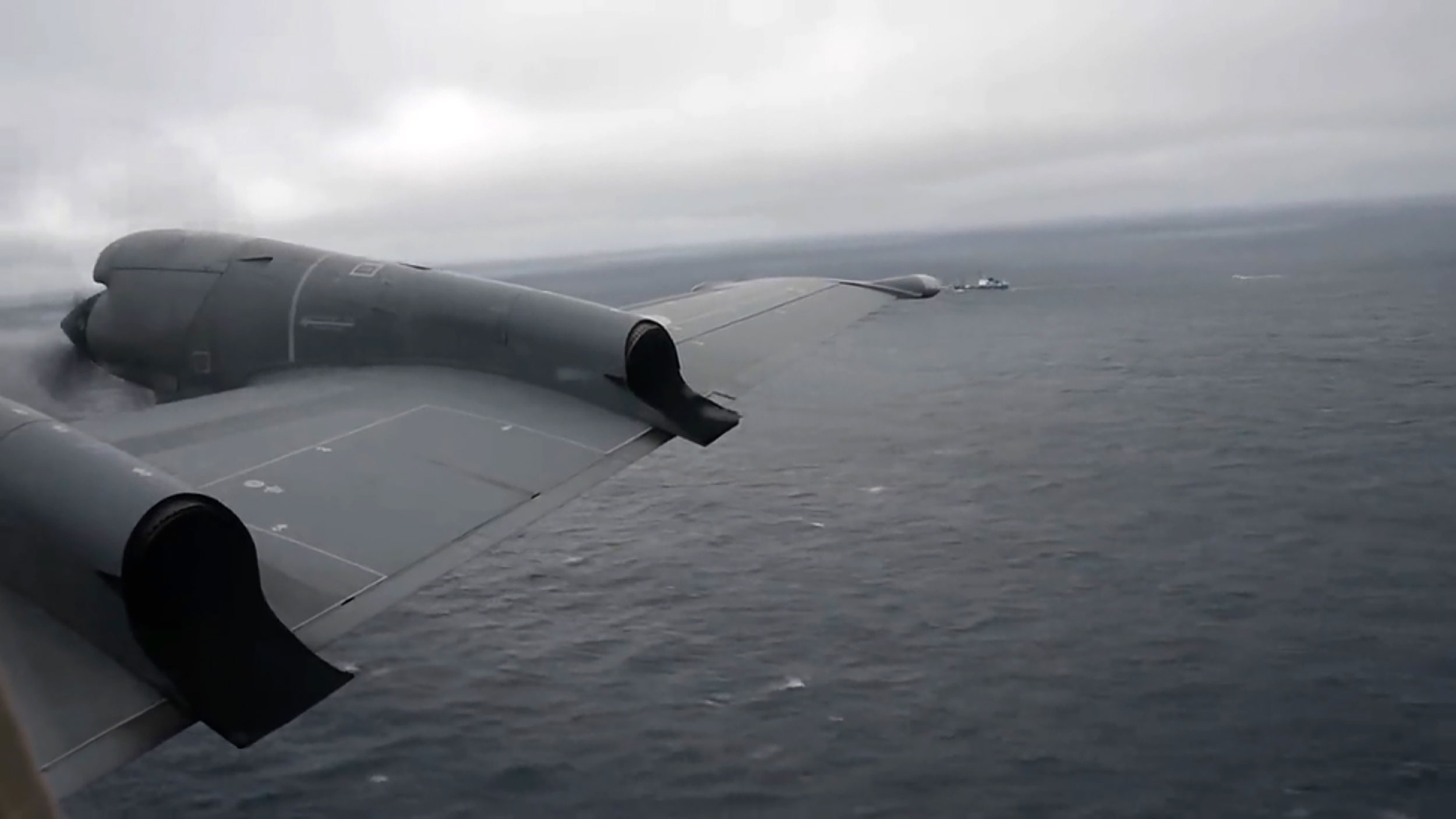
The search for the missing Titan submersible is now in a critical stage, as rescue teams race to locate the vessel before oxygen supplies run out.
The submersible begins each trip with 96 hours of life support and has been missing since Sunday, setting up Thursday morning as a key target for finding the vessel and those on board. Officials fear the craft’s oxygen supply could run out this morning.
Medical personnel and search vessels with extra capabilities headed to the scene on Thursday, with time running out.
If you're just reading in now, here's the latest news this morning:
- "New capabilities" in search: New, high-tech vessels and medical personnel are moving to the search site as rescue efforts reach a pivotal moment, a Coast Guard official has said. That includes a Magellan ROV, a uniquely equipped vessel whose use was pushed for by the Explorers Club group early on in the search.
- Search vehicle reaches sea floor: A remotely operated vehicle “has reached the sea floor” and has begun searching for the missing Titanic submersible early Thursday morning, according to the US Coast Guard. It added that “The French vessel L'Atalante is preparing their ROV to enter the water.”
- Concern over low-tech features: A former OceanGate subcontractor who worked on the development of the Titan submersible said while the game controller to operate the vessel may seem low-tech, it was actually by design. OceanGate tried to use as many “off-the-shelf" items as possible to cut down on research and development as well as costs, Doug Virnig told CNN Wednesday.
- How the sub went missing: The vessel, operated by OceanGate Expeditions, began its two-hour descent to the wreck of the Titanic on Sunday morning. (See how deep the wreckage is here. ) It lost contact with the Polar Prince, the support ship that transported the craft to the location in the North Atlantic, 1 hour and 45 minutes into its descent, officials said. Search operations began later that day. It’s still not clear what happened to the submersible, why it lost contact, and how close it was to the Titanic when it went missing.
- What we know about the noises : Banging noises were identified by Canadian aircraft on Tuesday and Wednesday morning. Remotely operated vehicle (ROV) equipment was relocated to where the noises were detected, according to Capt. Jamie Frederick, the response coordinator for the First Coast Guard District. But searches in the area "yielded negative results," he said. Data from the plane that identified the noises was sent to the US Navy, but has so far been inconclusive, Frederick said, adding that the Coast Guard does not know what the sounds were.
- What it could be like onboard: Officials believe the five people on board have "limited rations" of food and water. Ret. Navy Capt. David Marquet, a former submarine captain, told CNN the near-freezing water at that depth is probably making the situation very uncomfortable. "There's frost on the inside of the parts of the submarine. They're all huddled together trying to conserve their body heat. They're running low on oxygen and they're exhaling carbon dioxide," he said.
British submariner and equipment are assisting search efforts for missing sub
From CNN's Sharon Braithwaite and Luke McGee in London
A British navy submariner and equipment from a UK firm will help the search for the missing Titan submersible , a Downing Street spokesperson said Thursday.
"At the request of US Coastguard, the UK has embedded a Royal Navy submariner to assist the search and rescue effort for the missing submarine," the spokesperson said, according to UK's PA Media on Thursday.
Lt. Commander Richard Kantharia "has significant knowledge of submarine warfare and dived operations and so he will obviously be bringing that experience to the search and rescue team," the spokesperson added. The officer was on exchange with the US Navy and has been seconded to the search and rescue team, according to PA.
A British C-17 aircraft will transport “specialist commercial equipment” provided by deep sea-mapping company Magellan to St. John’s to assist with the search-and-rescue effort, PA also reported.
A spokesperson for Britain’s Royal Air Force told CNN on Thursday: “Following a request overnight from the lead organisation, RAF air transport assets are assisting with the movement of additional commercial equipment. ”
Along with the C-17, an A400 aircraft is transporting specialist loaders and crew, the air force said. Both aircraft departed RAF Lossiemouth in Scotland for Canada earlier on Thursday.
The missing submarine is carrying five people — a British adventurer, a French diver, a Pakistani father and son and the founder of OceanGate Expeditions, the company that operated the tour to the Titanic wreckage.
A massive search operation is underway in an area twice the size of Connecticut for the submersible that went missing Sunday —as officials fear the craft’s oxygen supply could run out this morning.
From Catherine Nicholls in London
Passengers on the missing sub would know to "take it easy" to save oxygen, friend of two onboard says
A friend of two passengers on board the missing submersible has said he still has hope the vessel will be found.
“I know that the adventurers on board are experienced, very experienced,” said Per Wimmer, an adventurer who was previously signed up for two canceled trips on the Titan.
Wimmer is an acquaintance of Hamish Harding and Stockton Rush, two of the five people on the missing vessel. He said Harding, a British businessman and trained jet pilot, and Rush, the CEO and founder of the company leading the voyage, are both very experienced adventurers who would know to conserve oxygen.
Wimmer said that the presence of OceanGate CEO Stockton Rush on board the vessel is helpful, as he knows “the ins and outs of how this submersible works.”
Officials fear the sub's oxygen supply would run out on Thursday, meaning the search is in a critical phase.
Medical personnel to join Titan search on Thursday, official says
From CNN's Kristina Sgueglia
New, high-tech vessels and medical personnel are moving to the search site as rescue efforts reach a pivotal moment, a Coast Guard official has said.
Rear Adm. John Mauger told NBC on Thursday that the search and rescue mission will continue with "new capability" arriving.
That includes a Magellan ROV, a uniquely equipped vessel whose use was pushed for by the Explorers Club group early on in the search. It has been questioned whether the Magellan should have been sent to the site much earlier in the search operation.
Mauger said they have been “overwhelmed by all the support that’s been provided by the international community” adding “we made some decisions to prioritize based on gear that was closest to the site and could get there.”
Mauger also said that medical personnel who have “deep sea medical expertise” are moving to the site, and a hyperbaric chamber is also en route.
“We continue to find in particularly complex cases that people's will to live really needs to be accounted for as well, and so we're continuing to search and proceed with rescue efforts by bringing this new capability online this morning,” he told NBC.
Search vehicle reaches sea floor as teams race to find sub
From CNN's Gloria Pazmino
A remote operated vehicle “has reached the sea floor” and has begun searching for the missing Titanic submersible early Thursday morning, according to the US Coast Guard.
“The Canadian vessel Horizon Arctic has deployed an ROV that has reached the sea floor and began its search for the missing sub,” the US Coast Guard tweeted .
It added that “The French vessel L'Atalante is preparing their ROV to enter the water.”
Titan submersible "is designed to come back up" after 24 hours, investor says
From CNN's Emma Tucker

The Titan submersible that went missing en route to the Titanic wreck was designed to return to the surface after 24 hours, according to Aaron Newman, an investor in OceanGate who visited the site on the vessel in 2021.
Titan is held underwater by ballast — heavy weights that helps with a vessel’s stability — built to be automatically released after 24 hours to send the sub to the surface, Newman said.
Crew members are told they can release the ballast by rocking the ship or use a pneumatic pump to knock the weights free, Newman said. If all else fails, he said, the lines securing the ballast are designed to fall apart after 24 hours to automatically send it back to the ocean’s surface.
Titan’s thrusters are powered by an external electrical system, while an internal system powers communications and a heater, Newman said.
Separately, Discovery Channel host Josh Gates , who went on a test dive on the Titan in 2021, said he learned that year that there were four ways for the vessel to shed weight and bring it back up to the surface in the case of an emergency.
There is a computer-controlled weight release, a manual-valve system that injects air into exterior ballast containers, a hydraulic system to drop weights and an ability to detach from the sled attached to the submersible and help move the vessel back to the surface.
Read more here .
"We need a miracle," Titanic exploration expert says
From CNN's Rob Picheta

Teams searching for the missing submersible “need a miracle” to find it before oxygen supplies run out, a leading deep-sea explorer told CNN.
“The good news there is that miracles can happen,” added David Gallo, the senior adviser for Strategic Initiatives at RMS Titanic Inc.
“We have to not think about the clock all the time, and just go as fast as possible,” Gallo told CNN’s “This Morning.” “It’s tough because the oceans are pitch black — you can only use sound to image effectively, and you’ve got to be pretty much on top of the object to actually see it,” he said.
Gallo is a colleague of French diver Paul-Henri Nargeolet, one of the passengers on the sub. He said that Nargeolet, an experienced explorer, would ensure that the banging noises picked up by search teams “cannot be interpreted as anything but human,” if indeed the noises did come from inside the vessel.
Thursday morning was identified as a critical period for the search operation, with oxygen supplies on board the sub understood to be rapidly dwindling.
Future research at the Titanic wreck is unlikely after the Titan went missing, expert says
The chances of future research being carried out at the Titanic wreck have diminished after the Titan sub went missing on its journey to the site, an expert has said.
David Scott-Beddard, the CEO of Titanic exhibition company White Star Memories Ltd, told CNN that the tragedy has “without a doubt” impacted opportunities to visit and study the wreckage.
“The chances of any future research being carried out on the wreck of Titanic is extremely slim. Probably not in my lifetime,” Scott-Beddard told CNN’s “Early Start.”
“I imagine there will be an inquiry no doubt after this disaster, and much more stringent rules and regulations will be put in place,” he said.
Concerns have been raised about the low-tech and controversial features of the OceanGate vessel . A former OceanGate subcontractor who worked on the development of the submersible Titan has said some of the construction materials and design choices were considered "controversial" at the time it was being made in 2018.
Enduring appeal: Several research trips were made to the Titanic site after it was discovered in 1985, and many of its artifacts have been controversially recovered and displayed around the world since. But commercial trips like those offered by OceanGate are a far more recent phenomenon.
“Titanic is one of those unreachable, unattainable things for most of us, unless you’ve been working in research and have been lucky enough to dive to the wreck in the past,” Scott-Beddard said, explaining the enduring appeal of the ship. “She sits majestically on the sea bed; (it’s) incredibly rare for a ship that sunk to be sitting upright.”
The ocean's depths are so elusive that only 20% of the seafloor has been mapped
From CNN's Jackie Wattles, Ashley Strickland and Katie Hunt

The submersible vehicle currently lost at sea is part of a relatively new effort enabling tourists and other paying customers to explore the depths of the ocean, the vast majority of which has never been seen by human eyes.
Though people have been exploring the ocean’s surface for tens of thousands of years, only about 20% of the seafloor has been mapped, according to 2022 figures from the National Oceanic and Atmospheric Administration.
Researchers often say that traveling to space is easier than plunging to the bottom of the ocean. While 12 astronauts have spent a collective total of 300 hours on the lunar surface, only three people have spent around three hours exploring Challenger Deep, the deepest known point of Earth’s seabed, according to the Woods Hole Oceanographic Institution .
There’s a reason deep-sea exploration by humans has been so limited: Traveling to the ocean’s depths means entering a realm with enormous levels of pressure the farther you descend — a high-risk endeavor. The environment is dark with almost no visibility. The cold temperatures are extreme.
Many of the factors that could make the vessel so difficult to locate and recover are also the reasons a comprehensive exploration of the ocean floor remains elusive.
“Aquatic search is pretty tricky, as the ocean floor is a lot more rugged than on land,” said Dr. Jamie Pringle, a reader in forensic geoscience at England’s Keele University, in a statement.
Read the full story here .
Please enable JavaScript for a better experience.
Filed under:
- US & World
The Titan’s implosion: the latest news on the Titanic wreckage tourist sub
By Wes Davis , a weekend editor who covers the latest in tech and entertainment. He has written news, reviews, and more as a tech journalist since 2020.
Share this story
On June 18th, 2023, a small sub called the Titan was lost about an hour and forty-five minutes into its voyage carrying five people on a tourist visit to the wreckage of the Titanic. After days of searching in the North Atlantic, the Coast Guard confirmed it found debris showing the sub suffered a “catastrophic implosion.”
The US Coast Guard had been searching beneath the ocean floor with remotely-operated vehicles (ROVs) while sonar — from planes overhead, buoys on the surface, and expedition ships — pinged the bottom of the ocean looking for signs of the sub.
However, on June 22nd, the Coast Guard reported an ROV found debris from the Titan about 1,600 feet from the bow of the Titanic. This led search crews to believe that the sub imploded shortly after its departure, killing all five passengers.
The sub carried 58-year-old British billionaire Hamish Harding, who flew on a Blue Origin suborbital flight in June 2022, Pakistani billionaire Shahzada Dawood and his son, Suleman Dawood, a 77-year-old French explorer named Paul-Henry Nargeolet, and the CEO of OceanGate, Stockton Rush, who was 61 years old.
The Titan was a small, five-person submersible that is designed to reach depths of 4,000 meters “for site survey and inspection, research and data collection, film and media production, and deep sea testing of hardware and software,” according to its operator OceanGate .
On the inside , it was little more than a tube with a single viewport, a small toilet, touchscreens for viewing sonar and controlling the sub, as well as a screen for viewing the external 8K camera’s feed. The “experimental vessel” was also controlled by a Logitech game controller. Eight-day trips, including the submersible dive to the Titanic, cost a reported $250,000 per seat.

Jun 22, 2023
Titan submersible suffered ‘catastrophic implosion’
:format(webp)/cdn.vox-cdn.com/uploads/chorus_asset/file/24745986/ocean_gate_titan.jpeg)
The Titan submersible, which disappeared after setting off to tour the wreckage of the Titanic on Sunday, experienced a “catastrophic implosion,” US Coast Guard Rear Admiral John Mauger announced during a press conference on Thursday afternoon.
“This morning, an ROV, or remote-operated vehicle from the vessel Horizon Arctic discovered the tail cone of the Titan submersible approximately 1,600 feet from the bow of the Titanic on the seafloor,” Mauger stated. “The ROV subsequently found additional debris. In consultation with experts from within the unified command, the debris is consistent with the catastrophic loss of the pressure chamber.”
Sep 29, 2023
A movie about the failed Titan submersible is already in the works
It’s only been months since the implosion of OceanGate’s Titan tourist submersible , but Hollywood producers are already working on a film based on the incident. MindRiot Entertainment will make the film, with E. Brian Dobbins ( The Blackening , Black-ish ) serving as co-producer, according to a report from Deadline .
The movie will follow the events that took place before, during, and after the Titan’s implosion, Deadline reports. In June, the Titan submersible set off on a journey to tour the wreckage of the Titanic at the bottom of the Atlantic Ocean. After losing contact with the surface , the US Coast Guard found that the Titan experienced a “catastrophic implosion” on the way down, killing all five passengers on board, including the CEO of OceanGate, Stockton Rush.

Jul 6, 2023
Richard Lawler
Yeah, that seems like a logical next move for OceanGate after the Titan vessel’s implosion killed five people, including OceanGate CEO Stockton Rush, as they traveled to the bottom of the Atlantic Ocean to visit the remains of the Titanic (via CNN ).
The company’s website still advertises $250,000 trips to the Titanic or hydrothermal vents in the Azores.
:format(webp)/cdn.vox-cdn.com/uploads/chorus_asset/file/24773409/oceangate_.jpg)
Jun 28, 2023
Photos published by CBS give us our first look at what remains of the Titan as crews work to bring debris from the sub to land. The tourist sub imploded last week during a journey to the Titanic’s wreckage, killing all five people on board.
Jun 26, 2023
Over the weekend, YouTuber and burger entrepreneur Mr. Beast tweeted that he had been invited to take a ride on the doomed Titanic tour submersible . However, one weird thing about his tweet was that while it clearly showed a screen capture from iMessage , it was a text from the sender, not the receiver.
He explained it later, saying it was a screenshot taken by the friend who originally invited him, who is probably also glad they didn’t take that particular trip.

Jun 25, 2023
CBS published a video today with more video from David Pogue’s November 2022 story about the Titan submersible , along with damning expert analysis of the flaws that likely led to the sub’s implosion .
The video shows a stark contrast between that analysis and the apparent overconfidence of OceanGate CEO Stockton Rush, who frequently pushed back on criticism and calls to seek safety certification of the sub.
YouTube creator MrBeast claimed in a tweet today that he was invited to join the Titan trip that disappeared on June 18th and was later determined to have imploded .
Curiously, the included screenshot of the invitation shows what appears to be a blue iMessage bubble. (Sent iMessages show as blue on the sender’s phone, not the receiver’s).
Update June 26, 8:25AM ET: He later tweeted that the screenshot was from the friend who invited him .
Jun 24, 2023
Travel Weekly EIC Arnie Weissman wrote a series of articles about a May trip he almost took aboard the OceanGate Titan (via Insider ).
He says OceanGate CEO Stockton Rush told him the sub’s hull used discounted Boeing carbon fiber that was “past its shelf life for use in airplanes” and claimed Boeing, NASA, and the University of Washington (UW) were involved in Titan’s design and testing.
Boeing and UW have both denied involvement, and NASA says it only served in a consulting capacity, per Insider .
[ www.travelweekly.com ]
The texts, which Bloom posted to Facebook, show Rush offering a cut-rate deal at just $150,000 per seat for a trip on the Titan. Bloom said he wasn’t able to go because of a scheduling conflict, and the slots went to Shahzada Dawood and his son, Sulemon, who were on the sub when it imploded .
In the texts, Bloom said his son was concerned about danger, but Rush waved him off:
“While there’s obviously risk it’s way safer than flying in a helicopter or even scuba divind. There hasn’t been even an injury in 35 years in a non-miltary sub.”
In 2019, after taking a trip on the ill-fated OceanGate Titan , submersible expert Karl Stanley said he heard an increasingly loud cracking sound over the two-hour trip down, according to The New York Times . He tried to warn Rush:
In the April 2019 email to Mr. Rush, Mr. Stanley said the loud cracking sounds that they had heard during their dive “sounded like a flaw/defect in one area being acted on by the tremendous pressures and being crushed/damaged.” He wrote that the loud, cracking noise signaled there was “an area of the hull that is breaking down.”
Stanley said experts confronted Rush about the safety of his sub at a 2018 crewed submersible conference, but he was “determined” to build it anyway. Shortly after, over three dozen industry experts wrote Rush, urging him to put his sub through certification.
[ The New York Times ]
Jun 23, 2023
Director James Cameron has given another interview, had a lot to say to CNN about the Titan , including that there’s an indication the sub dumped ballast and started to ascend before ever reaching the sea floor. He also apparently knew of the implosion sounds picked up by Navy listening devices as early as Monday.
However, despite OceanGate’s claims that they could detect any problems in the carbon fiber-based hull using “real-time (RTM) hull health monitoring,” Cameron said that well-known issues with composite materials and the risks of progressive degradation made it the wrong choice for constructing a submersible.
After the Titan lost contact with the surface, the WSJ reports that the US Navy “conducted an analysis of acoustic data” from a top-secret detection system.
It later found what it believes was the sound of the Titan’s implosion near the Titanic’s wreckage on Sunday, but officials decided to continue the search and rescue mission to “make every effort to save the lives on board.”
The Titanic director, who visited the remains of the 1912 shipwreck several times, responded to the news of the Titan tourist sub’s “catastrophic implosion” during an interview with ABC News:
A number of the top players in the deep submergence engineering community even wrote letters to the company [OceanGate], saying that what they were doing was too experimental to carry passengers and that needed to be certified. So I’m struck by the similarity of the Titanic disaster itself. The captain was repeatedly warned about ice ahead of his ship, and yet he steamed at full speed into an ice field on a moonless night.
The Coast Guard will hold a press briefing at 3PM ET to discuss its findings from the debris field that a remote-operated vehicle (ROV) uncovered at the bottom of the ocean near the Titanic.
The Titan tourist submersible began its journey toward the shipwreck on Sunday before losing contact with its support ship. The sub’s 96 hours supply of oxygen was expected to run out this morning .
Jun 21, 2023
Iron Lung , an $5.99 indie game for the PC and Switch, puts you inside a compact submarine where you must navigate an eerie ocean of blood using only the grainy pictures taken from outside the vessel.
The game’s developer, David Szymanski, saw sales spike on June 20th — just a couple of days after OceanGate’s tourist submersible lost contact with the surface. The sub, which is controlled using a simple Logitech gamepad , was supposed to journey toward the Titanic’s shipwreck that lies about 13,000 feet at the bottom of the ocean.
[ Polygon ]
A Canadian search aircraft with underwater detection capabilities picked up “banging” sounds coming from the depths around the HMS Titanic wreckage about every 30 minutes, per a US government memo obtained by CNN .
Rolling Stone , who first reported it, said an email to the Department of Homeland Security from the research group Explorers Society read:
“It is being reported that at 2 a.m. local time on site that sonar detected potential ‘tapping sounds’ at the location, implying crew may be alive and signaling.”
Knocking was heard 4 hours later when “additional sonar was deployed.”
Jun 20, 2023
The missing Titanic tour sub is steered with a simple Logitech gamepad
On Sunday morning, an OceanGate submarine vessel with five people aboard went missing in the Atlantic about an hour and forty-five minutes into a planned trip to explore the wreckage of the RMS Titanic. Made of carbon fiber and titanium, the vessel has enough air for 96 hours; however, as word of the emergency has spread, there’s also shock at the wireless Logitech F710 gamepad used for steering.
The Titan advertises “state-of-the-art lighting and sonar navigation systems plus internally and externally mounted 4K video and photographic equipment,” and this CBS News Sunday Morning segment from David Pogue, taken last summer, showed the reporter laughing as he was shown its controls. OceanGate CEO Stockton Rush holds up the F710, saying, “We run the whole thing... with this game controller.” The reporter refers to the “MacGyver jury-riggedness” of the whole thing, using many off-the-shelf parts, as Rush said, “certain things, you want to be button down,” noting work with Boeing and NASA.

Jun 19, 2023
Monica Chin
The vessel lost contact with its research vessel an hour and 45 minutes into its descent on Sunday morning. A search is underway approximately 900 miles east of Cape Cod.
The five occupants have between 70 and 96 hours of oxygen available, Coast Guard Rear Admiral John Mauger said at a press conference earlier today.
[ Washington Post ]
Human remains and debris from sub returned to land after fatal implosion near Titanic site
Human remains and debris from the submersible that imploded near the Titanic wreckage site was pulled from the depths of the ocean Wednesday, more than a week after a search for the five-passenger sub was launched and captured the world's attention.
Officials said medical professionals would study and analyze the presumed human remains that were carefully recovered from the wreckage.
The Titan, a submersible operated by OceanGate Expeditions, lost contact with its home ship June 18 off Newfoundland. Multiple countries sent resources in a frantic search for the sub, led by the U.S. Coast Guard.

Last Thursday, when the estimated oxygen supply would have been depleted, the Coast Guard said that debris had been discovered on the ocean floor near the bow of the wrecked Titanic and that all five on board had been killed.
It's believed the submersible imploded , and the cause is under investigation.
The sub's remains were recovered by a remote-operated vehicle, which was sent roughly 12,500 feet underwater, where the remains of the Titan were on the ocean floor.
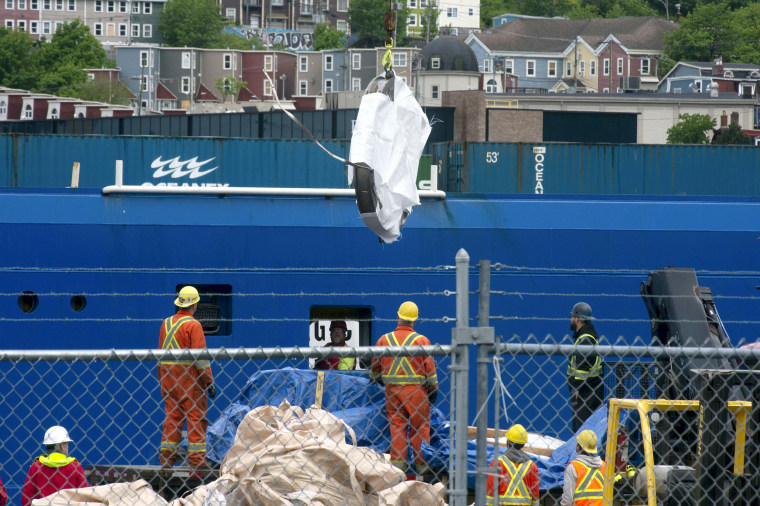
What appeared to be chunks of the sub were pulled up onto the Horizon Arctic, a Canadian ship. It's unclear what parts were recovered; one particularly large piece could be seen with several large wires attached to it.
The Canadian ship Horizon Arctic carried a remotely operated vehicle to search the ocean floor near the Titanic wreck for pieces of the submersible. Pelagic Research Services, the company with offices in Massachusetts and New York that owns the remote vehicle, said Wednesday that it has completed offshore operations.
The Marine Board of Investigation will transport the debris aboard a U.S. Coast Guard cutter to a port in the U.S., where it will be analyzed and tested.
Doha Madani is a senior breaking news reporter for NBC News. Pronouns: she/her.
Titanic submersible live updates: 'Catastrophic implosion' killed five aboard, possibly Sunday
Editor's note: This page reflects the news on the missing submarine from Thursday, June 22. For the latest updates on the missing submersible and the recovery efforts, read our live updates page for Friday, June 23 .
The five people aboard the submersible that had been missing for days were killed when the small vessel carrying them to the Titanic wreckage site had a "catastrophic implosion,'' the Coast Guard said Thursday afternoon.
Members of a massive international search effort found a debris field in the general area of the Titanic earlier in the day, and it was confirmed to contain parts of the Titan sub.
"The debris is consistent with a catastrophic implosion of the vessel," Rear Adm. John Mauger, commander of the First Coast Guard District, said in a news conference.
The debris was found about 1,600 feet from the Titanic's bow on the sea floor, Mauger said, adding that it was too early to tell when the Titan imploded.
However, an "anomaly'' the U.S. Navy detected Sunday was likely the small watercraft's fatal blast, according to a senior military official. The irregularity was picked up when the Navy went back and analyzed its acoustic data after the submersible was reported missing that day.
That anomaly was “consistent with an implosion or explosion in the general vicinity of where the Titan submersible was operating when communications were lost,” a senior Navy official told The Associated Press, speaking on condition of anonymity. The Navy shared the information with the Coast Guard, but the data was not considered definitive.
Paul Hankins, the U.S. Navy director of salvage operations and ocean engineering, said the debris found Thursday indicated a "catastrophic event." He and Mauger said it included a tail cone, the end bell of the pressure hull and the aft end bell, which according to Hankins, "basically comprise the totality of that pressure vessel."
The 22-foot vehicle was on a dive to the Titanic site when it lost contact with its support ship Sunday morning.
OceanGate, the company that operated the Titan – and whose CEO, Stockton Rush, piloted the watercraft – issued a statement saying the travelers "have sadly been lost.''
"We grieve the loss of life and joy they brought to everyone they knew,'' the statement said.
The other four people believed to have perished were Pakistani businessman Shahzada Dawood and his son Suleman Dawood, British adventurer Hamish Harding and French deep-sea explorer and Titanic expert Paul-Henri Nargeolet.
“Our hearts go out to the families and loved ones of those who lost their lives on the Titan,” the White House said in a statement. “They have been through a harrowing ordeal over the past few days, and we are keeping them in our thoughts and prayers.”
Debris field discovered early Thursday
Search and rescue crews remotely operating an underwater vehicle had discovered debris near the Titanic earlier Thursday, the day the submersible was expected to run out of oxygen .
The debris was found by a remotely operated vehicle (ROV) associated with the Canadian vessel Horizon Arctic that reached the sea floor and began searching for the submersible early Thursday, according to the Coast Guard, which said ROVs will be used in a continued investigation of what happened.
The complex search and rescue mission attracted international attention and involved personnel from the U.S., Canada, France and the United Kingdom . Another ROV, associated with the French vessel L'Atalante, also deployed Thursday, the Coast Guard said.
The accelerating search efforts came as an updated prediction by the Coast Guard said the Titan submersible was likely to run out of oxygen roughly around 7 a.m. EDT Thursday. It initially had 96 hours of oxygen for a crew of five. Experts have noted that the estimates are imprecise. In the end, running out of oxygen was not the biggest problem.
Inside the underwater vessel: Reporter who rode Titanic submersible tells USA TODAY about 'less sophisticated' parts
Wife of OceanGate CEO descended from Titanic victims
The wife of OceanGate's CEO is descended from victims of the Titanic wreck of 1912, genealogical records suggest.
Wendy Rush, the wife of Stockton Rush, is the great-great-granddaughter of Isidor and Ida Straus , The New York Times first reported . USA TODAY confirmed the tie through genealogical records online.
The couple was last seen together on the deck of the Titanic holding hands as it sank, according to the U.K. government's National Archives. Rush's great-grandmother was their daughter Minnie, who married Richard Weil, said Joan Adler, executive director of the Straus Historical Society, a nonprofit that preserves information relating to the Straus Family.
Rush works as OceanGate's director of communications and has participated in three past OceanGate journeys to the Titanic site, according to her LinkedIn page .
Pakistani teen was student in Scotland
Suleman Dawood, the Pakistani 19-year-old aboard the vessel, was a student at the University of Strathclyde in Glasgow, Scotland, the university confirmed Thursday. He just completed his first year in the business school there.
"We are deeply concerned about Suleman, his father and the others involved in this incident. Our thoughts are with their families and loved ones and we continue to hope for a positive outcome," the university said.
Deep ocean salvage system arrives for search
Rescue crews on Thursday had faced wind gusts up to 19 mph and ocean swells up to 5 feet, with an air temperature of 50 degrees Fahrenheit, according to the Coast Guard.
The U.S. Navy said Wednesday afternoon that a special deep-water salvage system capable of hoisting up to 60,000 pounds had reached St. John’s, Canada, and could be used to lift the Titan to the surface, though it may not be ready for another 24 hours. The Titan weighs 23,000 pounds, according to the OceanGate website.
Submersible previously had battery issues
At least 46 people successfully traveled on OceanGate’s submersible to the Titanic wreck site in 2021 and 2022, according to letters the company filed with a U.S. District Court in Virginia.
"On the first dive to the Titanic, the submersible encountered a battery issue and had to be manually attached to its lifting platform," one filing says. "In the high sea state, the submersible sustained modest damage to its external components and OceanGate decided to cancel the second mission for repairs and operational enhancements."
Arthur Loibl, a retired businessman from Germany, took a dive to the site two years ago. "Imagine a metal tube a few meters long with a sheet of metal for a floor. You can't stand. You can't kneel. Everyone is sitting close to or on top of each other," Loibl told the Associated Press. "You can't be claustrophobic."
During the 2.5-hour descent and ascent, the lights were turned off to conserve energy, he said, with the only illumination coming from a fluorescent glow stick. The dive was repeatedly delayed to fix a problem with the battery and the balancing weights. In total, the voyage took 10.5 hours, he said.
Underwater noises heard for two days
Aircraft detected underwater noises in the search area on Tuesday and Wednesday, prompting officials to redirect rescue efforts, said Capt. Jamie Frederick, the First Coast Guard District response coordinator, in a news conference Wednesday. Navy acoustic analysts were studying the sounds, he said.
"We don't know what they are," Frederick said. "The good news is, we’re searching in the area where the noises were detected." The search net covers a surface area roughly two times the size of Connecticut and 2.5 miles deep, he said.
At the press conference Wednesday, Carl Hartsfield, director of the Woods Hole Oceanographic Institution, said the sounds have been described as "banging noises." He cautioned against jumping to conclusions and said sounds that aren’t man-made may sound man-made to the untrained ear.
Missing Titanic submersible: Maps, graphics show last location, depth and design
Who is on the passenger list of the submersible?
These are the passengers who were on the submersible :
◾ Stockton Rush, 61, CEO of OceanGate, who co-founded the company in 2009.
◾ Paul-Henry Nargeolet, 73, a French maritime explorer and director of the Underwater Research Program at Premier Exhibitions, RMS Titanic Inc., the only company with exclusive rights to recover the artifacts from the Titanic wreck.
◾ Hamish Harding, 58, a British explorer, private jet dealer and chairman of Action Aviation, a global sales company in business aviation.
◾ Shahzada Dawood, 48, a member of one of Pakistan’s most prominent families.
◾ Suleman Dawood, 19, son of Shahzada Dawood.
– Isabelle Butera, USA TODAY
Who pays the cost of Coast Guard rescues?
The cost of the search and rescue mission is likely in the millions of dollars – and will fall to taxpayers, said Chris Boyer, the executive director of the National Association for Search and Rescue, a nonprofit education, training and advocacy group.
He said the Coast Guard doesn’t charge people for search and rescue. "That’s their job," he said, noting fear of costs could deter people from seeking lifesaving help.
While some adventure expeditions require patrons to take out insurance policies, few would come close to covering the likely costs of the rescue mission, he said. High-risk adventures have long fueled complex debates about risk and rescue, he said.
"I think it's going to become a larger issue for us. Because it's not just under the water. We now have private spaceships flying private astronauts into space," he said. "What happens when that private spaceship can't come back home?"
– Chris Kenning, USA TODAY
What does it look like inside the missing submersible?
The Titan submersible was about 8 feet high, 9 feet wide and 22 feet long, according to the OceanGate website. It was designed to reach about 13,000 feet deep and travel at 3 knots, the company says. The vessel had a five-inch-thick carbon fiber and titanium hull and four 10-horsepower electric thrusters, according to court filings.
Several exterior cameras provided a live view of the outside, and passengers could access the camera views on a large digital display or on a hand-held tablet, according to court filings. Images posted to the website show people seated on the floor in the small, open space with their legs crossed.
Science writer and CBS correspondent David Pogue, who boarded the submersible for a report that aired in November , told USA TODAY he was concerned about the vessel's safety.
"There were parts of it that seemed to me to be less sophisticated than I was guessing. You drive it with a PlayStation video controller … some of the ballasts are old, rusty construction pipes," Pogue said. "There were certain things that looked like cut corners."
Contributing: Kayla Jimenez, Dinah Pulver and Anthony Robledo, USA TODAY ; The Associated Press
- Yekaterinburg
- Novosibirsk
- Vladivostok

- Tours to Russia
- Practicalities
- Russia in Lists
Rusmania • Deep into Russia
Out of the Centre
Savvino-storozhevsky monastery and museum.

Zvenigorod's most famous sight is the Savvino-Storozhevsky Monastery, which was founded in 1398 by the monk Savva from the Troitse-Sergieva Lavra, at the invitation and with the support of Prince Yury Dmitrievich of Zvenigorod. Savva was later canonised as St Sabbas (Savva) of Storozhev. The monastery late flourished under the reign of Tsar Alexis, who chose the monastery as his family church and often went on pilgrimage there and made lots of donations to it. Most of the monastery’s buildings date from this time. The monastery is heavily fortified with thick walls and six towers, the most impressive of which is the Krasny Tower which also serves as the eastern entrance. The monastery was closed in 1918 and only reopened in 1995. In 1998 Patriarch Alexius II took part in a service to return the relics of St Sabbas to the monastery. Today the monastery has the status of a stauropegic monastery, which is second in status to a lavra. In addition to being a working monastery, it also holds the Zvenigorod Historical, Architectural and Art Museum.
Belfry and Neighbouring Churches

Located near the main entrance is the monastery's belfry which is perhaps the calling card of the monastery due to its uniqueness. It was built in the 1650s and the St Sergius of Radonezh’s Church was opened on the middle tier in the mid-17th century, although it was originally dedicated to the Trinity. The belfry's 35-tonne Great Bladgovestny Bell fell in 1941 and was only restored and returned in 2003. Attached to the belfry is a large refectory and the Transfiguration Church, both of which were built on the orders of Tsar Alexis in the 1650s.

To the left of the belfry is another, smaller, refectory which is attached to the Trinity Gate-Church, which was also constructed in the 1650s on the orders of Tsar Alexis who made it his own family church. The church is elaborately decorated with colourful trims and underneath the archway is a beautiful 19th century fresco.
Nativity of Virgin Mary Cathedral

The Nativity of Virgin Mary Cathedral is the oldest building in the monastery and among the oldest buildings in the Moscow Region. It was built between 1404 and 1405 during the lifetime of St Sabbas and using the funds of Prince Yury of Zvenigorod. The white-stone cathedral is a standard four-pillar design with a single golden dome. After the death of St Sabbas he was interred in the cathedral and a new altar dedicated to him was added.

Under the reign of Tsar Alexis the cathedral was decorated with frescoes by Stepan Ryazanets, some of which remain today. Tsar Alexis also presented the cathedral with a five-tier iconostasis, the top row of icons have been preserved.
Tsaritsa's Chambers

The Nativity of Virgin Mary Cathedral is located between the Tsaritsa's Chambers of the left and the Palace of Tsar Alexis on the right. The Tsaritsa's Chambers were built in the mid-17th century for the wife of Tsar Alexey - Tsaritsa Maria Ilinichna Miloskavskaya. The design of the building is influenced by the ancient Russian architectural style. Is prettier than the Tsar's chambers opposite, being red in colour with elaborately decorated window frames and entrance.

At present the Tsaritsa's Chambers houses the Zvenigorod Historical, Architectural and Art Museum. Among its displays is an accurate recreation of the interior of a noble lady's chambers including furniture, decorations and a decorated tiled oven, and an exhibition on the history of Zvenigorod and the monastery.
Palace of Tsar Alexis

The Palace of Tsar Alexis was built in the 1650s and is now one of the best surviving examples of non-religious architecture of that era. It was built especially for Tsar Alexis who often visited the monastery on religious pilgrimages. Its most striking feature is its pretty row of nine chimney spouts which resemble towers.

Plan your next trip to Russia
Ready-to-book tours.
Your holiday in Russia starts here. Choose and book your tour to Russia.
The Unique Burial of a Child of Early Scythian Time at the Cemetery of Saryg-Bulun (Tuva)
<< Previous page
Pages: 379-406
In 1988, the Tuvan Archaeological Expedition (led by M. E. Kilunovskaya and V. A. Semenov) discovered a unique burial of the early Iron Age at Saryg-Bulun in Central Tuva. There are two burial mounds of the Aldy-Bel culture dated by 7th century BC. Within the barrows, which adjoined one another, forming a figure-of-eight, there were discovered 7 burials, from which a representative collection of artifacts was recovered. Burial 5 was the most unique, it was found in a coffin made of a larch trunk, with a tightly closed lid. Due to the preservative properties of larch and lack of air access, the coffin contained a well-preserved mummy of a child with an accompanying set of grave goods. The interred individual retained the skin on his face and had a leather headdress painted with red pigment and a coat, sewn from jerboa fur. The coat was belted with a leather belt with bronze ornaments and buckles. Besides that, a leather quiver with arrows with the shafts decorated with painted ornaments, fully preserved battle pick and a bow were buried in the coffin. Unexpectedly, the full-genomic analysis, showed that the individual was female. This fact opens a new aspect in the study of the social history of the Scythian society and perhaps brings us back to the myth of the Amazons, discussed by Herodotus. Of course, this discovery is unique in its preservation for the Scythian culture of Tuva and requires careful study and conservation.
Keywords: Tuva, Early Iron Age, early Scythian period, Aldy-Bel culture, barrow, burial in the coffin, mummy, full genome sequencing, aDNA
Information about authors: Marina Kilunovskaya (Saint Petersburg, Russian Federation). Candidate of Historical Sciences. Institute for the History of Material Culture of the Russian Academy of Sciences. Dvortsovaya Emb., 18, Saint Petersburg, 191186, Russian Federation E-mail: [email protected] Vladimir Semenov (Saint Petersburg, Russian Federation). Candidate of Historical Sciences. Institute for the History of Material Culture of the Russian Academy of Sciences. Dvortsovaya Emb., 18, Saint Petersburg, 191186, Russian Federation E-mail: [email protected] Varvara Busova (Moscow, Russian Federation). (Saint Petersburg, Russian Federation). Institute for the History of Material Culture of the Russian Academy of Sciences. Dvortsovaya Emb., 18, Saint Petersburg, 191186, Russian Federation E-mail: [email protected] Kharis Mustafin (Moscow, Russian Federation). Candidate of Technical Sciences. Moscow Institute of Physics and Technology. Institutsky Lane, 9, Dolgoprudny, 141701, Moscow Oblast, Russian Federation E-mail: [email protected] Irina Alborova (Moscow, Russian Federation). Candidate of Biological Sciences. Moscow Institute of Physics and Technology. Institutsky Lane, 9, Dolgoprudny, 141701, Moscow Oblast, Russian Federation E-mail: [email protected] Alina Matzvai (Moscow, Russian Federation). Moscow Institute of Physics and Technology. Institutsky Lane, 9, Dolgoprudny, 141701, Moscow Oblast, Russian Federation E-mail: [email protected]
Shopping Cart Items: 0 Cart Total: 0,00 € place your order
Price pdf version
student - 2,75 € individual - 3,00 € institutional - 7,00 €

Copyright В© 1999-2022. Stratum Publishing House

IMAGES
VIDEO
COMMENTS
On 18 June 2023, Titan, a submersible operated by the American tourism and expeditions company OceanGate, imploded during an expedition to view the wreck of the Titanic in the North Atlantic Ocean off the coast of Newfoundland, Canada.Aboard the submersible were: Stockton Rush, the American chief executive officer of OceanGate; Paul-Henri Nargeolet, a French deep-sea explorer and Titanic ...
01:55 - Source: CNN. CNN —. Authorities have said the Titanic-touring submersible that went missing on Sunday suffered a "catastrophic implosion," killing all five people on board while ...
0:00. 1:47. Five men, including one teenager, have been declared dead days after they left for a voyage in a 22-foot submersible to see the wreckage of the Titanic in the North Atlantic Ocean ...
All five people aboard the Titan submersible are believed to be dead, and debris discovered in the search area was consistent with a "catastrophic implosion," the U.S. Coast Guard said. The debris ...
The Titan submersible bound for the Titanic that went missing on Sunday with five people on board suffered a "catastrophic implosion," US Coast Guard Rear Adm. John Mauger said Thursday. Now ...
OceanGate has provided tours of the Titanic wreck since 2021 — for a price of up to $250,000 per person — as part of a booming high-risk travel industry. The company has described the trip on ...
June 22, 2023 Updated 5:17 PM PT. NEW YORK —. All five passengers aboard a submersible that vanished while on a dive to explore the Titanic wreck site have died, officials said Thursday after ...
It's unclear where or how deep the Titan was when the implosion occurred, but the Titanic wreck sits nearly 13,000 feet (or almost 4,000 meters) below sea level. The submersible was about 1 hour ...
June 22, 2023. A vast multinational search for five people who had descended to view the wreckage of the sunken R.M.S. Titanic ended on Thursday after pieces of the privately owned submersible ...
A flood or a failure of the pressure vessel would have likely caused the implosion, says submarine expert Eric Fusil ... OceanGate has been chronicling the Titanic's decay and the underwater ...
Officials determined a "catastrophic implosion" killed the five people aboard the Titan vessel after starting its dive to view the Titanic wreckage site.The U.S. Navy analyzed its acoustic data ...
Submersible passengers were killed in implosion: Coast Guard After days of searching the ocean depths, rescuers confirmed they found debris of the tourist submersible and said the five passengers ...
Published 9:02 PM PDT, June 21, 2023. A submersible carrying five people to the Titanic imploded near the site of the shipwreck and killed everyone on board, authorities said Thursday, bringing a tragic end to a saga that included an urgent around-the-clock search and a worldwide vigil for the missing vessel.
Catastrophic implosion: The Titanic-bound submersible that went missing on Sunday ... The missing submarine is carrying five people — a British adventurer, a French diver, a Pakistani father and ...
On June 18th, 2023, a small sub called the Titan was lost about an hour and forty-five minutes into its voyage carrying five people on a tourist visit to the wreckage of the Titanic. After days of ...
June 28, 2023, 3:36 PM PDT. By Doha Madani. Human remains and debris from the submersible that imploded near the Titanic wreckage site was pulled from the depths of the ocean Wednesday, more than ...
The accelerating search efforts came as an updated prediction by the Coast Guard said the Titan submersible was likely to run out of oxygen roughly around 7 a.m. EDT Thursday. It initially had 96 ...
The Titanic, largely thought to be unsinkable at the time, hit an iceberg on its maiden voyage from Southampton in the U.K. to New York on April 15, 1912. The tragedy claimed the lives of more ...
After a dayslong, massive search for a Titanic-bound submersible that captured international attention, US authorities announced the vessel had suffered a "catastrophic implosion" - and new ...
3 Institute for the Study of War and AEI's Critical Threats Project 2024 migrant workplaces and increase crackdowns at border crossings to temporarily placate emotional cries
In 1954, Elemash began to produce fuel assemblies, including for the first nuclear power plant in the world, located in Obninsk. In 1959, the facility produced the fuel for the Soviet Union's first icebreaker. Its fuel assembly production became serial in 1965 and automated in 1982. 1. Today, Elemash is one of the largest TVEL nuclear fuel ...
Zvenigorod's most famous sight is the Savvino-Storozhevsky Monastery, which was founded in 1398 by the monk Savva from the Troitse-Sergieva Lavra, at the invitation and with the support of Prince Yury Dmitrievich of Zvenigorod. Savva was later canonised as St Sabbas (Savva) of Storozhev. The monastery late flourished under the reign of Tsar ...
Burial 5 was the most unique, it was found in a coffin made of a larch trunk, with a tightly closed lid. Due to the preservative properties of larch and lack of air access, the coffin contained a well-preserved mummy of a child with an accompanying set of grave goods. The interred individual retained the skin on his face and had a leather ...